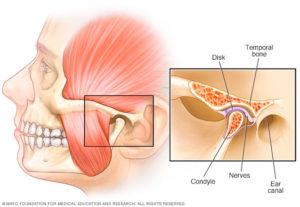Temporomandibular Joint (TMJ)
TMJ Dysfunction
Temporomandibular Joint (TMJ) Dysfunction — a type of Temporomandibular Disorder (TMD) — can cause pain in your jaw joint and in the muscles that control jaw movement. TMJ acts like a sliding hinge, connecting your jawbone to your skull. You have one joint on each side of your jaw. The TMJ disorder may be due to a combination of factors, such as genetics, arthritis, jaw injury, clenching or grinding of teeth (bruxism).

Signs and symptoms of TMJ disorders may include:
- Pain or tenderness of your jaw
- Pain in one or both of the temporomandibular joints
- Aching pain in and around your ear.
- Ringing in the ear.
- Difficulty chewing or pain while chewing
- Aching facial pain
- Locking of the joint, making it difficult to open or close your mouth
- Clicking, popping and grating sounds
- Tired/tight jaws, Neck and Shoulder
- A bite that feels uncomfortable or “off”
- Pain behind the eye
Causes
The temporomandibular joint combines a hinge action with sliding motions. The parts of the bones that interact in the joint are covered with cartilage and are separated by a small shock-absorbing disk, which normally keeps the movement smooth.
Painful TMJ disorders can occur if:
- The disk erodes or moves out of its proper alignment
- The joint’s cartilage is damaged by arthritis
- The joint is damaged by a blow or other impact
In many cases, however, the cause of TMJ disorders isn’t clear.
Risk Factors that may increase the risk of developing TMJ disorders include:
- Various types of arthritis, such as rheumatoid arthritis and osteoarthritis
- Jaw injury
- Long-term (chronic) grinding or clenching of teeth
- Certain connective tissue diseases that cause problems that may affect the temporomandibular joint
Diagnosis
Dr. Behzadi-Shannon will discuss your symptoms and examine your jaw:
- Listen to and feel your jaw when you open and close your mouth
- Observe the range of motion in your jaw
- Press on areas around your jaw to identify sites of pain or discomfort
- Doppler Auscultation
- CT scan to provide detailed images of the bones involved in the joint
Treatment
Nondrug therapies for TMJ disorders include:
- Oral splints or mouth guards
- Physical therapy
Along with exercises to stretch and strengthen jaw muscles, treatments might include ultrasound, moist heat, and ice.
- Cranial osteopathic manipulative medicine
An Osteopath will aim to provide symptomatic relief of pain in the related structures of the jaw, head, neck, back & shoulders. This may allow for reflex relaxation of the jaw to settle symptoms of jaw pain and may also assist with a better nights sleep. Osteopaths are also trained to treat muscles within the mouth (with gloves) to access muscles directly related to the jaw that may be in spasm. - Orofacial myofunctional therapy (OMT)
The technique is based on the neuromuscular re-education or re-patterning of the oral and facial muscles, and includes facial exercises and behavior modification techniques to promote proper tongue position, improved breathing, chewing, and swallowing. Proper functional head and neck postures are also addressed.
Contact us for a consult appointment
Contact Us
Sorry we are experiencing system issues. Please try again.
Sorry we are experiencing system issues. Please try again.
Sorry we are experiencing system issues. Please try again.
CONTACT US (619) 930-9811